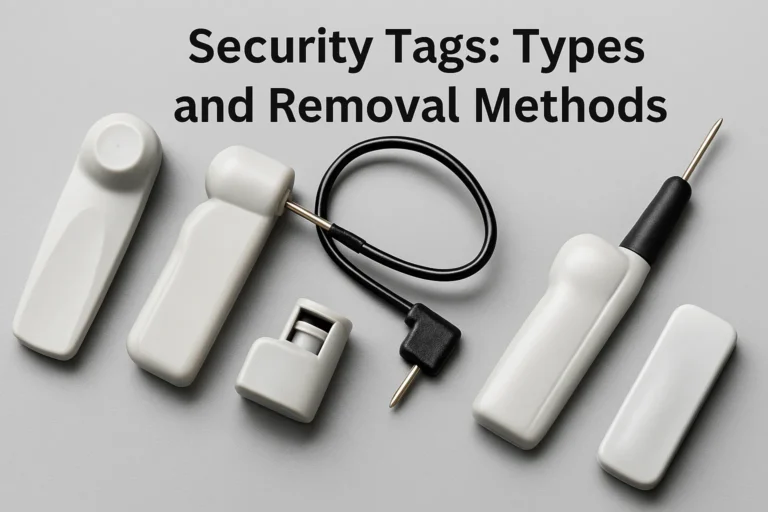In an era where retail experiences can make or break a brand, securing merchandise is more critical than ever. India’s retail landscape is undergoing a transformation, and at the forefront of this revolution are Electronic Article Surveillance EAS anti theft system. These innovative solutions are not just about deterring theft; they’re about creating a safer shopping environment that enhances customer trust. As retailers embrace cutting-edge technology, EAS systems are proving to be a game-changer, effectively reducing shrinkage and improving profitability. With increasing foot traffic in stores across the country, the need for robust security measures has never been more pressing. Discover how EAS anti-theft systems are redefining the retail experience in India, combining technology, efficiency, and peace of mind for both retailers and shoppers alike. Unlocking security is not just a necessity; it’s the key to thriving in a competitive retail market.
The Current State of Retail Security in India
India’s retail sector is one of the fastest-growing in the world, contributing significantly to the country’s GDP. However, with the expansion of both physical stores and online platforms, security concerns have escalated. Retail theft, or shrinkage, remains a substantial challenge, adversely affecting profitability and inventory accuracy. According to a recent report, Indian retailers experience an average shrinkage rate of around 2-3% annually, which may seem minimal but translates to substantial financial losses.
The traditional methods of retail security, such as manual surveillance and basic CCTV systems, have proven insufficient in curbing these losses. Shoplifters, armed with increasingly sophisticated tactics, often find ways to circumvent these outdated security measures. The need for more advanced and reliable security solutions has become glaringly apparent.
In response to these challenges, Electronic Article Surveillance (EAS) systems have emerged as a beacon of hope. These systems, leveraging cutting-edge technology, offer a robust and efficient solution to the persistent issue of retail theft. By integrating EAS systems into their security protocols, retailers can ensure a safer shopping environment, discourage theft, and ultimately protect their bottom lines.
What are EAS Anti-Theft Systems?
Electronic Article Surveillance (EAS) systems are a type of technology used to prevent shoplifting in retail stores. They work by affixing electronic tags to merchandise. When an item with an active tag passes through the EAS antenna, typically located at store exits, an alarm sounds, alerting store personnel to potential theft. This highly effective method acts as both a deterrent and a detection mechanism.
EAS systems come in various forms, including acousto-magnetic (AM), radio frequency (RF), and electromagnetic (EM) systems. Each has its unique features and benefits, catering to different types of retail environments. For instance, AM systems are known for their high detection rates and are often used in stores with wide exit points, while RF systems are more cost-effective and suitable for smaller retail spaces.
The adoption of EAS technology in India is growing, driven by the need to reduce shrinkage and enhance store security. With the rise of organized retail and increasing consumer footfall, the demand for sophisticated anti-theft solutions has never been higher. EAS systems not only help in safeguarding merchandise but also contribute to a seamless and pleasant shopping experience, reinforcing customer trust and loyalty.
Key Components of EAS Technology
EAS technology comprises several key components that work in tandem to ensure the security of merchandise. The primary elements include electronic tags, detection systems, and deactivation or detaching devices. Each of these components plays a crucial role in the overall effectiveness of the EAS Anti Theft System.
Electronic tags are perhaps the most critical component. These tags are attached to merchandise and come in various forms, such as hard tags, soft tags, and label tags. Hard tags are typically used for apparel and can be reused multiple times, while soft tags are often used for smaller items and can be deactivated at the point of sale. Label tags are adhesive and can be applied directly to product packaging.
Detection systems, or antennas, are strategically placed at store exits. These systems emit a specific frequency that interacts with the tags. When a tagged item passes through the detection zone without being deactivated, the system triggers an alarm. Detection systems can vary in size and shape, depending on the store layout and the level of security required.
Deactivation and detaching devices are used at the point of sale to neutralize the tags. Deactivation devices, such as deactivation pads, are used for soft tags and label tags, rendering them inactive once the item is purchased. Detaching devices, on the other hand, are used to remove hard tags from merchandise. These devices ensure that legitimate purchases do not trigger the alarm, allowing customers to leave the store without any inconvenience.
Benefits of Implementing EAS Anti Theft System
The implementation of EAS systems in retail stores offers a multitude of benefits, making them an invaluable investment for retailers. One of the most significant advantages is the reduction in shrinkage. By deterring potential thieves and detecting unauthorized removal of merchandise, EAS Anti Theft system help retailers minimize losses due to theft. This directly impacts profitability, allowing retailers to reinvest in their businesses and offer better prices and services to customers.
Another notable benefit is the enhancement of store security. EAS systems create a secure shopping environment, instilling confidence in both customers and employees. When customers know that a store has robust security measures in place, they are more likely to feel safe and have a positive shopping experience. Similarly, employees can focus on providing excellent customer service without constantly worrying about theft.
EAS systems also contribute to operational efficiency. Traditional security measures, such as manual surveillance, can be labor-intensive and prone to human error. In contrast, EAS systems automate the detection and deterrence of theft, allowing retailers to allocate their resources more effectively. Moreover, EAS Anti Theft System can be integrated with other security solutions, such as CCTV and inventory management systems, providing a comprehensive approach to retail security.
Case Studies: Successful EAS Implementations in India
The success of EAS Anti Theft systems in India can be illustrated through several case studies of retailers who have effectively implemented this technology. One notable example is the fashion retail giant, Shoppers Stop. Faced with high shrinkage rates, Shoppers Stop adopted EAS systems across their stores. The implementation led to a significant reduction in theft, improving inventory accuracy and boosting profitability. The seamless integration of EAS with their existing security measures ensured a smooth transition and enhanced overall store security.
Another successful case is that of Big Bazaar, one of India’s largest hypermarket chains. Big Bazaar faced challenges with shoplifting due to the high volume of foot traffic in their stores. By implementing EAS systems, they were able to curb theft effectively. The use of hard tags on high-value items and soft tags on smaller merchandise created a multi-layered security approach. This not only deterred potential thieves but also provided a sense of security for customers, contributing to a better shopping experience.
A third example is the electronics retailer Croma. Electronics stores are particularly vulnerable to theft due to the high value and small size of the products. Croma’s adoption of EAS technology, especially acousto-magnetic systems, provided robust protection against shoplifting. The implementation resulted in a noticeable decrease in shrinkage and allowed Croma to maintain competitive pricing by reducing losses. The success of EAS systems in these retailers demonstrates their effectiveness and the tangible benefits they offer.
Challenges Faced in Adopting EAS Anti Theft System
Despite the numerous benefits, the adoption of EAS systems in India is not without challenges. One of the primary obstacles is the initial cost of implementation. Setting up EAS Anti Theft System involves purchasing tags, detection systems, and deactivation devices, which can be a significant investment for small and medium-sized retailers. Additionally, there are ongoing costs associated with maintaining and updating the systems to ensure they remain effective.
Another challenge is the potential for false alarms. While EAS technology has advanced significantly, there is still a possibility of false alarms, which can be disruptive and negatively impact the customer experience. False alarms can be caused by various factors, such as interference from other electronic devices or improperly deactivated tags. Retailers need to ensure that their staff is adequately trained to handle such situations and minimize disruptions.
Integration with existing systems can also pose a challenge. Many retailers already have security measures in place, such as CCTV and inventory management systems. Integrating EAS technology with these existing systems can be complex and may require additional resources and expertise. Retailers need to plan the integration process to ensure that the different systems work seamlessly together, providing comprehensive security without redundancy.
Future Trends in EAS Technology
As technology continues to evolve, so too does EAS technology. One of the future trends in EAS is the integration of RFID (Radio Frequency Identification) technology. RFID tags offer several advantages over traditional EAS tags, including the ability to store more information and be read from a greater distance. This allows for more detailed inventory tracking and management, providing retailers with valuable insights into their stock levels and movement.
Another emerging trend is the use of advanced analytics and artificial intelligence (AI) in EAS systems. By leveraging AI, EAS systems can analyze patterns and detect anomalies in real-time, providing more accurate and timely alerts. This can help retailers identify potential theft more effectively and take proactive measures to prevent it. Additionally, AI can help reduce false alarms by distinguishing between legitimate and suspicious activities.
The future of EAS technology also includes greater integration with mobile devices. Mobile EAS solutions allow store personnel to receive alerts and manage the system from their smartphones or tablets. This provides greater flexibility and allows for quicker responses to potential theft incidents. Mobile integration also enhances the overall customer experience by allowing staff to assist customers more efficiently without being tied to a fixed location.
Comparing EAS Systems with Other Security Solutions
While EAS systems offer numerous benefits, it is essential to compare them with other security solutions to understand their relative advantages. One common alternative is CCTV surveillance. CCTV systems provide real-time monitoring and can capture evidence of theft, which can be useful for prosecution. However, CCTV systems are primarily reactive, as they rely on human operators to identify and respond to incidents. In contrast, EAS systems are proactive, deterring theft before it occurs.
Another alternative is the use of security personnel. Security guards can provide a visible deterrent and respond to suspicious activities in real-time. However, relying solely on security personnel can be costly and subject to human error. EAS systems, on the other hand, offer a more cost-effective and consistent solution. They can operate continuously without the need for breaks and are not influenced by human biases.
Inventory management systems with built-in security features are also an option. These systems can track stock levels and identify discrepancies that may indicate theft. While they are useful for detecting internal theft, they may not be as effective in preventing shoplifting by customers. EAS systems complement inventory management systems by providing an additional layer of security at the point of sale and exits, ensuring comprehensive protection.
Conclusion: The Future of Retail Security in India
The retail landscape in India is rapidly evolving, and so are the security challenges that come with it. As retailers strive to provide exceptional shopping experiences while safeguarding their merchandise, EAS systems have emerged as a crucial component of modern retail security. By reducing shrinkage, enhancing store security, and improving operational efficiency, EAS systems offer a comprehensive solution to the persistent issue of retail theft.
The successful implementation of EAS systems by leading retailers in India, such as Shoppers Stop, Big Bazaar, and Croma, underscores their effectiveness and the tangible benefits they bring. However, the adoption of EAS technology is not without challenges, including the initial cost of implementation, potential for false alarms, and integration with existing systems. Retailers must carefully navigate these challenges to fully realize the benefits of EAS systems.
Looking ahead, the future of EAS technology is promising, with advancements such as RFID integration, AI-driven analytics, and mobile solutions set to transform retail security further. As these technologies evolve, they will provide even more robust and efficient solutions, helping retailers stay ahead of potential threats and maintain a secure shopping environment.
In conclusion, unlocking security through EAS anti-theft systems is not just a necessity for Indian retailers; it is a strategic imperative. By embracing this innovative technology, retailers can protect their merchandise, enhance customer trust, and ultimately thrive in a competitive market. The future of retail security in India is bright, and EAS systems will undoubtedly play a pivotal role in shaping it.



